|
written by: Michael Adu-Brew & Ben Burgunder
When most people think of mathematicians, scenes of squawking flocks of birds being herded into arenas, tiny ticks being carefully painted with nail polish, and an army of permethrin-soaked undergraduate researchers do not come to mind. These people do not know Dr. Holly Gaff. On Friday, October 27th, Dr. Gaff, Professor and Chair of Biological Sciences at Old Dominion University (ODU), spoke to the UMD Department of Entomology about her exciting research on the ticks of southeastern Virginia. A mathematician by training, Dr. Gaff was ‘bitten’ by the tick research bug when she realized how mathematical modeling and simulation could help decipher the complex and unpredictable life histories of ticks that threaten public health across the country. Dr. Nicolas Medina and Postdoc Mentor, Dr. Anahi Espindola, partnered up with Univ of Wyoming colleague Dr. David C. Tank to create a more robust evolutionary tree for Calceolaria. Using a new bait set gene sequencing method on recent and historic specimens of Calceolariaceae they were able to recover data for a wide range of DNA qualities at multiple phylogenetic scales. The results in this study demonstrate the efficacy of this new approach, which the authors hope, will be adopted for use in other systems. Their study entitled, "Calceolariaceae809: A bait set for targeted sequencing of nuclear loci", is out this week in Applications in Plant Sciences.
Share your colleagues' latest pub on X, facebook or other networks. In a paper just published in Developmental Biology, Matthew Fischer (MOCB alum), Patricia Graham (Research Scientist) and Leslie show that a regulatory element thought to be essential for gene expression in the early Drosophila embryo is actually not required for gene expression or for wild type development. They used CRISPR-Cas9 genome editing to remove this DNA region from the genome. Unexpectedly, flies homozygous for this deletion are viable, fertile, and perfectly healthy in the lab. This finding demonstrates the importance of using different types of techniques to tackle research questions. It also raises new questions about the evolution of regulatory elements and their roles in extant species.
Share your colleagues work on facebook, X and/or other platforms you use. by: Alireza Shokoohi, Robert Salerno and Leo Kerner
Native pollinators are the largely unsung heroes of our ecosystems, but they face an alarming risk that we've long underestimated. New research from Dr. Vera Krischik’s lab shows that the situation may be more dire than expected. Dr. Krischik is an Associate Professor and Extension Specialist at the University of Minnesota investigating the impact of neonicotinoid insecticide residues on pollinators such as wild bees and butterflies. Her research is crucial for understanding and protecting the lives of these beneficial insects that we often take for granted. By Amanda Brucchieri and Helen Craig
Imagine biking down a road, along the edge of a cornfield with stalks reaching far above your head. Drifting across your path, riding the breeze, is a monarch butterfly. It flutters and then glides as butterflies do, looking for the next patch of flowers to feed and rest. Bursting from this peaceful scene comes a team of scientists with nets, scopes, and chirping walkie-talkies. They are on a mission. They are tracking the same monarch that had just coasted by using radio telemetry. Professors Mike Raupp and Paula Shrewsbury team up with U.S. Department of Agriculture and Washington State University colleagues to help put to rest long standing uncertainty on whether or not adult Magicicada cicadas eat. Spoiler Alert! They do. See publication in the Journal of Insect Science for the “full” story on cicadas' newly confirmed feeding behaviors.
For even more check out news articles interviewing lead researcher James R Hepler: https://phys.org/news/2023-10-adult-periodical-cicadas.html https://www.sciencenews.org/article/debunk-periodic-cicada-myth-guts https://www.earth.com/news/do-periodical-cicadas-eat-when-theyre-above-ground/ Share further on facebook, X and with your other networks. Dr. Magdalene Ngeve and Postdoc Mentor (Dr. Maile Neel), as well as other fellow UMD and UMCES researchers, published a study in Ecology and Evolution. They examined how tropical storms Irene and Lee affected the genetic diversity of aquatic plants in the lower Hudson River Estuary. Researchers collected samples of Vallisneria americana Michx. (Hydrocharitaceae) before and after the storms. Checking DNA markers, they were surprised to find the plants as a whole were able to sustain genetic diversity. However, they celebrate these findings with caution. These plant populations were already small and reproduced mainly asexually relying on making exact copies of themselves, which doesn't add to genetic diversity. If more severe storms and human disturbances continue along the Hudson, these plants might struggle to recover. For a more complete understanding of long-term resilience, the authors would like to see more ongoing monitoring of genetic diversity and population size.
Share your colleagues latest pub via facebook, x and your other networks. [Seminar Blog] The Battle for Blood - How Mosquito Salivary Proteins Facilitate Blood Feeding10/4/2023
written by: Jenan El-Hifnawi, Ben Gregory, and Minh Le
Imagine it’s a hot summer day and you’re slurping down a strawberry milkshake. Suddenly you’re interrupted by a pesky little ice chip clogging your straw. While this experience is all too familiar among your fellow humans, you may not have guessed that mosquitoes share a similar struggle! University of Maryland #InsectTerps wrap up summer 2023 at EntoQuest. This meeting, hosted by the Eastern Branch of the Entomological Society of America at Delmarva Bay, gave attendees a hands-on way to learn about what's going on with entomology as a profession. From fossil hunts to forensic workshops the group had a bug-last.
National Postdoc Appreciation Week was celebrated at academic institutions across the U.S. last week. For Ento postdocs, faculty and grad students events included a dept coffee-and-snacks get together and participation in the UMD Postdoctoral Research Symposium where postdocs across campus presented their research. At the symposium two members of our Department were highlighted for their contribution as postdoc researchers and mentors.
This summer Dr. Megan Fritz, Assoc Prof University of Maryland, flexed her sci-comms skills at the Capitol, joining fellow Entomological Society of America researchers to advocate for continued and increased federal investments in life-science research. https://go.umd.edu/3OV2Kgy
Congratulations to Profs Anahí Espíndola and Macarena Farcuh for being named Runners Up for The Entomological Society of America's Science Communication Award. ESA recognized the pair for their increasingly popular blog, Extension en Espanol.
From ESA's press release: The blog has published more than 100 posts since its creation, offering varied expert information that is inclusive, culturally relevant, accessible, and understandable to its target population. The blog currently reaches more than 9,000 monthly readers and has become a prime extension resource in Spanish for the state and beyond. Help spread the word about your colleagues award and blog by sharing with your networks on social ( X and facebook) and other platforms. UMD Research Scientist, Rafael Barreto de Andrade (Gruner Lab), has been collaborating with European researchers on a pretty big project - consolidating multi-taxon biodiversity databases from more than 3,500 (!) sampling units across Europe, with the aim to inform conservation and management strategies for European forests. This summer their work was published in Biological Conservation.
Thanks Rafael for sharing the results of this very exciting collaboration! To share Rafael's collab further, consider retweeting, liking the mention on FB, shouting across the hall to your colleagues, etc.  Meet one of the "craziest creatures" University of Maryland Professor Emeritus Mike Raupp has ever seen, the hammerhead worm. Not only is this worm aptly named for the shape of its head, it secretes the same neurotoxin found in puffer fish & has cannibalistic tendencies. https://www.washingtonpost.com/weather/2023/07/22/hammerhead-worms-invasive-poisonous-dc/ https://bugoftheweek.com/blog/2023/7/24/hammer-time-in-the-dmv-hammerhead-worms-bipalium-spp Share this info on the "craziest creature" with friends, family and coworkers via facebook, twitter or other platforms. Postdoctoral position in Fungal-Plant-Insect Associations, St. Leger Lab
Position summary: The St. Leger laboratory, Department of Entomology at The University of Maryland (UMD), invites applications for a Postdoctoral Scholar – Employee position starting when a qualified applicant is found-on a USDA/NSF funded project entitled “Determining the properties required for a genetically engineered biocontrol agent to work safely”. The candidate post-doctoral associate will work on a unique experimental system involving a radiating genus of fungi (Metarhizium spp) which have rapidly diversifying lifestyles that includes associations with plants and insects. The goal is to ask fundamental questions about invasion ecology (including persistence, propagation, potential horizontal gene transfer and biogeochemical impacts), potential adaptation in the field (e.g., divergence in insect and plant associations), mutational capacity (using genomic sequencing) and transgene stability. The project will provide insights into the genetic and molecular underpinnings determining evolutionary shifts in lifestyles that will be generally applicable to pathogens and hosts. Understanding these shifts is critical, especially in light of environmental change, invasive species and the laboratories work on transgenic approaches to controlling vectors of human disease. A combination of experimental approaches will be used, and there will be many opportunities to develop new projects to explore the evolution of lifestyle shifts. Follow link to view full job announcement. 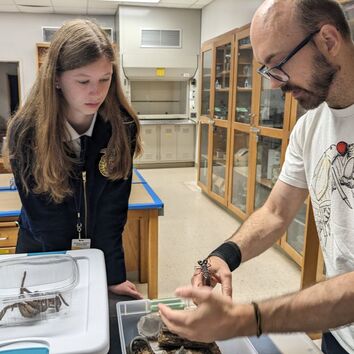 Waters displaying insect to Future Farmers of America participant. Waters displaying insect to Future Farmers of America participant. It is with great enthusiasm we share that Todd Waters has received the University System of Maryland Board of Regents’ Staff Award for his “Extraordinary Public Service to the University & Greater Community.” Todd has been a leader in implementing the educational and land grant mission of our university, using insects to educate students and the public about STEM. Since 2017, Todd has maintained a blistering pace with the Insect Zoo. The zoo has been featured in approx. 100 events, reaching approx. 10,000 people. In this short time, he has had an immensely positive influence on learners from across academic environments. At UMD, Todd has been instrumental in: the Insect Petting Zoo at Maryland Day, an event that President Pines and UMD’s First Lady eagerly wait alongside community members for their chance to hold an insect; Entomology minor recruitment events on Hornbake Plaza where Todd talks up insects’ impacts on our environment; and classroom visits where Todd and Entomology professors introduce undergrads to the incredible diversity of arthropods. A few examples of the type of impact Todd’s Outreach work has had include: a classroom discussion with a Montgomery College Biology Class about insects as models across interdisciplinary studies; a presentation at Rockview Elementary School on insect anatomy and metamorphosis; and an exhibit in St. Mary's County where attendees learned about the Arizona blonde tarantula, among other fascinating arthropods. Join us in congratulating Todd on this well-deserved recognition! 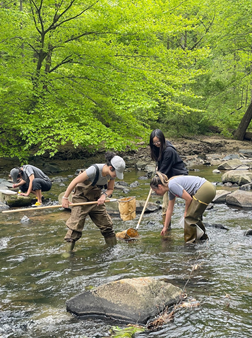 Undergraduates from across disciplines joined Dr. Bill Lamp & Grad Assistant Amanda Rae Brucchieri for an i-series course ripped from the headlines, “BSCI145 The Insect Apocalypse: Real or Imagined”, a new course that encouraged students to learn more about the natural world and interpret scientific information presented to them. Over the semester students applied their knowledge through hands-on experiences in the classroom, lab and even field trips. Earlier in May while some of us were scrolling through photos of the coronation across the pond, Prof Emerita Dr. Barbara Thorne was quoted talking about another monarch - the Termite King. She told The New York Times that "“There are some parallels to our monarchy system for humans.” Read article here>>
Congratulations to Dr. Tammatha O'Brien, Principal Lecturer & Director of The Master of Professional Studies in Applied Entomology Program, for being named among UMD's Women of Influence. Tammatha is an outstanding lecturer who consistently and meaningfully supports women minorities in our community both inside and outside of the classroom. Fellow faculty member Louisa Wu says, “She cares very much about students and her colleagues, and she strongly promotes DEI and civil rights work in her teaching and campus service. I am inspired by all that she does.”
written by: Leo Kerner & Angela Saenz
Imagine a lush, highly diverse field of papaya that requires limited chemical interference to control insect and weed pests. This is the reality of living mulch. Dr. Robin Gomez, an associate professor of Weed Science at the University of Costa Rica, studies sustainable pest control methods in tropical ecosystems. He suggests that the key to successful implementation of sustainable agricultural practices relies on acquiring specialized knowledge of each system. When you see a honey bee buzzing around, or while you spread honey on your toast, have you ever wondered how old the honey bees that are visiting flowers or making honey are? The answer is: it depends. Worker honey bees assume different jobs in their life, and that role changes with age. Young workers take care of the colony, nursing and feeding the larvae. Later they become guards, protecting the hive. When the worker bee is even older, they take on the job of exploring the outdoors and foraging nectar and pollen for the colony. So, a bee pollinating a flower is probably older than the bee that made your honey.
written by: Mariom Carvajal
Insects are critical to the function of ecosystems and provide benefits to humans, such as pollination and biological control. Although many insects hold great economic and cultural value to humans and benefit our lives, some reduce agricultural productivity and others pose risks to human health. To find new ways to manage these pests, some Entomologists turn to the study of invisible cellular processes or insect-microbe interactions. Two research in progress talks presented on March 10th 2023 by University of Maryland researchers, Dr. Anastasia Naumenko and Mr. Brendan Randall, focused on how knowledge of these microscopic processes can be used for the benefit of agricultural and public health systems. By Ben Gregory
These days, most Americans don’t worry too much about malaria, the deadly disease caused by the Plasmodium parasite and spread by Anopheles mosquitoes (Figure 1, left). That wasn’t always the case, however. In fact, during the nineteenth century, malaria was one of the leading causes of death in the United States, affecting nearly every corner of the country, but particularly the south (Hong 2008). Fortunately for those of us living here today, malaria is extremely rare. This is thanks to sweeping control and public health measures taken by the CDC and its predecessor organizations in the early and mid-twentieth centuries. But, more recently, another mosquito-borne disease of concern has spread across the country: West Nile fever. [Seminar Blog] Caste-switching jumping ants: studies on the plasticity of reproduction and lifespan5/3/2023
By Megan Ma
Dr. Francisco Carmona-Aldana (he/him), a postdoctoral scholar at the New York University School of Medicine, recently presented his research on “Ants: studies on the plasticity of reproduction and lifespan” which focuses on how ants obtain tradeoffs between reproduction and longevity through caste-switching. In the collaborative projects led by Dr. Danny Reinberg and Dr. Claude Desplan, he and his team study ants of the species Harpegnathos saltator as an experimental model to understand how aging can be regulated. H. saltator ants are peculiar in that workers can become pseudo-queens and take reproductive control of their colonies when a queen is absent. A group of 4 to 6 ants will undergo antennal dueling, a behavioral interaction to determine who will become pseudo-queens, or “gamergates.” These gamergates will have active ovaries, lay eggs, and extend their lifespans to accommodate this reproductive caste-switching. They live for 3 years in comparison to their lifespan as a former worker (1 year) and the maximum lifespan found in queens (5 years). In addition to altering the duration of their lifespans, gamergates have the potential to revert back to their worker states (induced in laboratory conditions). They can return to their original, non-reproductive role to perform their worker duties and no longer produce eggs. Written by: Lindsay Barranco
Dr. Krisztina Christmon has measured approximately 100,000 mites during the course of her PhD studies at the University of Maryland, which may very well be a world-record. She recently presented her research exit seminar entitled “Varroa destructor: abiotic and biotic correlates to body size, and the effects of size and host type on mite tolerance to acaricide exposure” and described how her inquiry into mite size variability began in 2016, as a new PhD student in the UMD Bee Lab. The UMD Bee lab administers the National Honeybee Disease Survey (NHDS), and maintains collected data from large and small-scale beekeepers across the United States in order to detect honey bee disease and monitor for invasive species. Invasive species, particularly varroa mites, pose a serious threat to honey bee health which in turn, potentially impacts the important pollination services honey bees provide to fruit and vegetable growers nationwide. |
Categories
All
Archives
June 2024
|
Department of Entomology
University of Maryland
4112 Plant Sciences Building
College Park, MD 20742-4454
USA
Telephone: 301.405.3911
Fax: 301.314.9290
University of Maryland
4112 Plant Sciences Building
College Park, MD 20742-4454
USA
Telephone: 301.405.3911
Fax: 301.314.9290

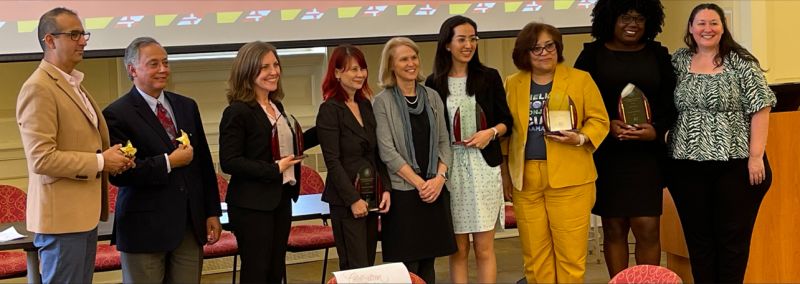
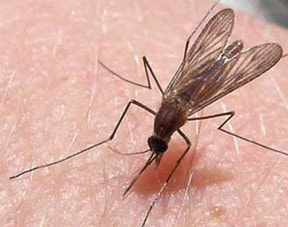
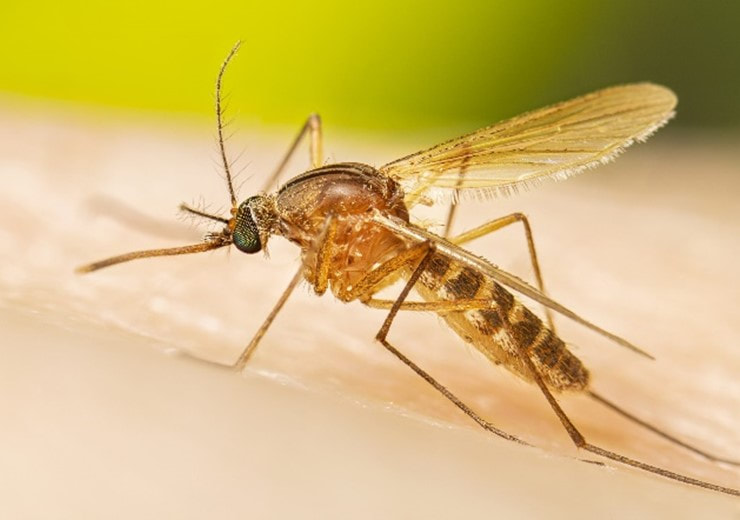
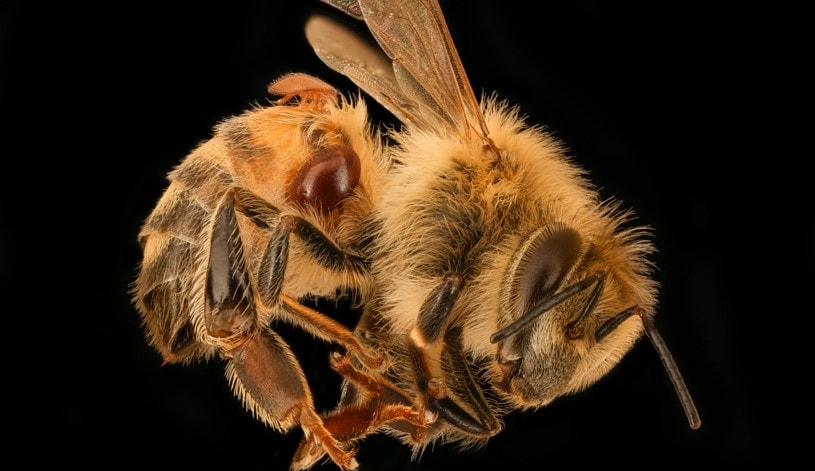
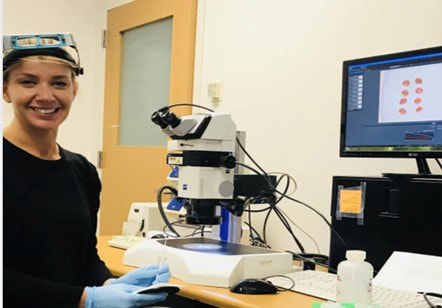
 RSS Feed
RSS Feed




